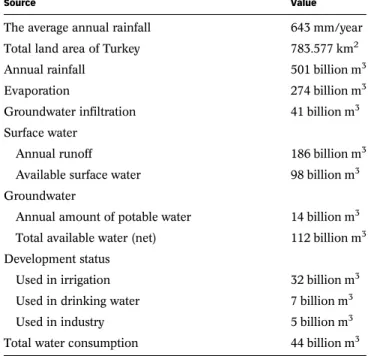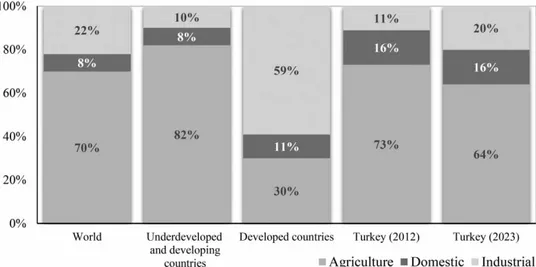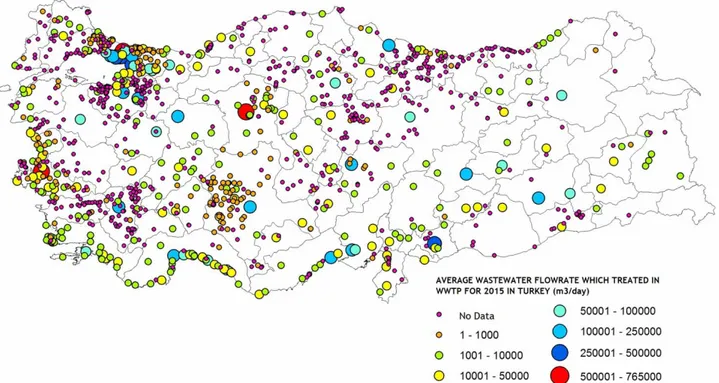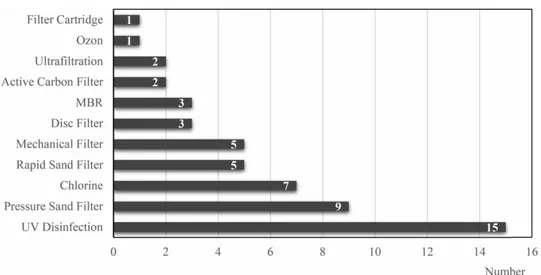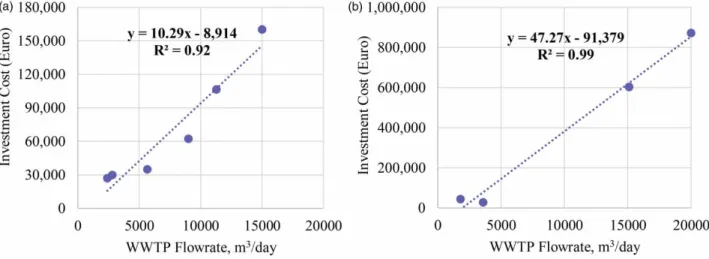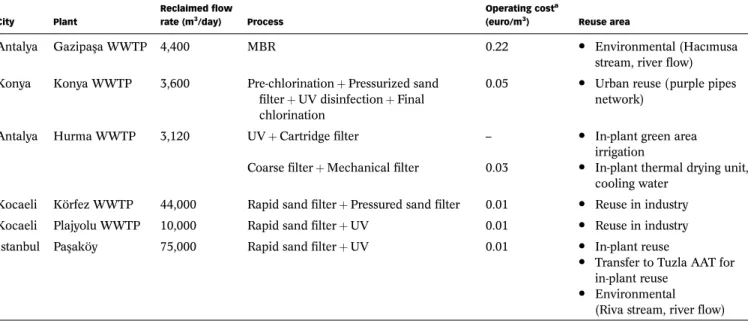Wastewater reuse in Turkey: from present status to future
potential
Bilgehan Nas
, Sinan Uyanik
, Ahmet Aygün, Selim Doğan,
Gürsel Erul, K. Batuhan Nas, Sefa Turgut, Mustafa Cop and Taylan Dolu
ABSTRACT
The Ministry of Environment and Urbanization (MoEU) initiated an important project,‘Reuse of Treated Wastewater in Turkey’, in 2017. With this project, all wastewater treatment plants (WWTPs) were investigated to determine wastewater reuse purposes for thefirst time. The results obtained from this project were that although there are 1,015 existing WWTPs, only 15 of them realized wastewater reuse. In 2017, the total volume of reused treated wastewater in Turkey amounted to 29.6 million m3/year, accounting for 0.78% of the treated urban wastewater. With the present water
potential and sectoral water use rates, Turkey should make key administrative and technical regulations in the coming years for water reuse. This paper aims to give an overview of wastewater reuse activities from present status to future potential in Turkey and the opportunities and challenges in expanding water reuse. The status of WWTPs, treatment processes and their compliance with the WWTPs where reuse is carried out in Turkey are evaluated in this study. The realization of the planned goals and challenges are discussed after regulatory changes in Turkey for reclaimed wastewater and reuse targets for 2023.
Bilgehan Nas (corresponding author) Selim Doğan
Taylan Dolu
Department of Environmental Engineering, Konya Technical University, Konya, Turkey E-mail: bnas@ktun.edu.tr Bilgehan Nas K. Batuhan Nas Sefa Turgut Mustafa Cop
Arbiotek Environmental Solutions Research and Development Ltd Co.,
Selcuk University Technology Development Zone, Konya,
Turkey
Sinan Uyanik
Department of Environmental Engineering, Harran University, Şanlıurfa,
Turkey
Ahmet Aygün
Department of Environmental Engineering, Bursa Technical University, Bursa, Turkey
Gürsel Erul
Ministry of Environment and Urbanization, General Directorate of Environmental
Management, Ankara, Turkey
K. Batuhan Nas Sefa Turgut
Graduate School of Natural Sciences, Konya Technical University, Konya, Turkey
Key words|advanced treatment, reclaimed water, wastewater, wastewater regulations, water reuse
INTRODUCTION
The world population is expected to be 9.7 billion and 10.9 billion by the years 2050 and 2100 respectively based on medium-variant projection according to the World Popu-lation Prospects 2019 report published by the United Nations (UN ). Both the limited water resources and increase in demand for these resources all over the world in parallel with rapid population growth are considered, and the necessity of reusing water which actually has been applied via different techniques since ancient times
(Angelakis et al. ) has become unavoidable in today’s conditions in order to increase the water supply. The sol-utions of water reuse remain limited in comparison with their potential. The goal is to encourage using resources ef fi-ciently and reduce the pressure on water scarcity by fostering the development of safe reuse (Alcalde-Sanz & Gawlik). Water reuse presents a potential for water management and contributes to reducing fresh water use. On the other hand, contribution to sustainable water management and resource doi: 10.2166/ws.2019.136
conservation should be adopted without compromising public health or environmental risk (Al-Jayyousi).
Reuse of water has many advantages such as provision of drinking water especially in countries suffering from water scarcity, improved agricultural production, reduction of energy costs related to production and all other signifi-cant environmental benefits (EPA ). The two most important factors that should be considered in the appli-cation of different purposes in the scope of water reuse are energy efficiency and sustainability (NCSL). In this con-text, water resources should be planned scrupulously by taking into consideration the water reuse trend for the con-sumption of both present and future generations. In other words, sustainable water management is required to prevent or solve water-related challenges (WCED ). However, most countries are not at the desired level in the field of water reuse. On the other hand, developing countries especially, such as Turkey, are carrying out comprehensive studies on water reuse projects to meet urban demands such as landscape irrigation, agricultural, commercial and industrial needs. The most realistic project that can be implemented within this context is the safe reuse of wastewater at an increas-ing rate accordincreas-ing to the principle of ‘fit for purpose’ considering both cost and health concerns (NRC).
There is no certain standardization of water reuse cri-teria throughout the world (Paranychianakis et al. ). Water quality should be improved for more consistency among different international regulations (Angelakis et al. ).Paranychianakis et al. ()conducted a very compre-hensive study that reviews the evolution of water reuse criteria and the criteria in EU countries and its comparison among the countries; this study reviewed water reuse and the public health/environmental risk dimension as well. Alcalde-Sanz & Gawlik ()prepared a report that scienti-fic support for the development of a legal instrument on minimum quality requirements for water reuse at EU level for irrigation and aquifer recharge should be adopted. There are diverse water reuse realities amongst the countries of the European Union. Whilst in southern Europe waste-water reuse is still a limited, but growing, source of irrigation water, in northern Europe, it is barely practiced but could be developed for sanitation or environmental protection purposes in response to increasingly stringent environmental regulations. In 2006, the total volume of
reused treated wastewater in the EU amounted to 964 million m3/year, accounting for 2.4% of the treated urban wastewater (Raso).
Water reuse continues to be a viable option for enhan-cing water resources in developing countries. One of the ongoing challenges is to convince, not only the commu-nities, but also the political leadership. An array of barriers, including cultural beliefs and investment opportu-nities continue to influence opportuopportu-nities for progress negatively (Hyde ). A key factor in the successful implementation of wastewater reuse is the public accep-tance that can be provided by the high quality of reclaimed water (Asano et al.).
Turkey is not a water-rich country in terms of existing water potential. The total, technically and economically usable surface and groundwater potential of Turkey is around 112 billion m3, with 96 billion m3 (86%) coming from rivers located within Turkish borders, 3 billion m3 (3%) from external rivers originating outside the country’s borders and 12 billion m3 (11%) from groundwater resources. The water resource potential of Turkey is given inTable 1.
Turkey is situated in a semi-arid region and water demand increases with population growth, industrialization, Table 1|Water resource potential of Turkey (State Hydraulic Works 2017)
Source Value
The average annual rainfall 643 mm/year
Total land area of Turkey 783.577 km2
Annual rainfall 501 billion m3
Evaporation 274 billion m3
Groundwater infiltration 41 billion m3
Surface water
Annual runoff 186 billion m3
Available surface water 98 billion m3
Groundwater
Annual amount of potable water 14 billion m3
Total available water (net) 112 billion m3
Development status
Used in irrigation 32 billion m3
Used in drinking water 7 billion m3
Used in industry 5 billion m3
urbanization and rising usage. The utilization rate of 112 billion m3of available water resources in Turkey is approxi-mately 39%; 32 billion m3 of this resource is used for irrigation (73%), 7 billion m3 (16%) is used for drinking water and urban usage, and 5 billion m3(11%) is used in industry. As of 2013, Turkey is among the countries with limited water resources, with 1,500 m3 of available water per capita. It is expected that Turkey may become one of the countries suffering from water shortage with 1,100 m3 of available water per capita in the year 2030 (MoD).
The sectoral distribution of water use according to the development levels and industrial water usage in Turkey in comparison with other countries is given in Figure 1. According to the water consumption estimates made on a sectoral basis, all of the 8.5 million hectares area, which is the technically and economically irrigable land resource of the country, is expected to be open to irrigation in 2023 and the consumption of irrigation water to reach 72 billion m3 (MoD ). Thus, it is aimed to reduce the share of the irrigation, which was 73% of total water consump-tion at the beginning of 2012, to 64% based on the target of 2023. In addition, Turkey used 5 billion m3/year for industry in 2012, and it is expected to use 22 billion m3/year of water in industry in 2023. Furthermore, it is estimated that the drinking/potable water demand, which was approximately 7 billion m3 per year in 2012, will reach 18 billion m3 in 2023. With the present water potential and sectoral water use rates, Turkey should make key
administrative and technical regulations in the coming years in the reuse of treated wastewater area.
The AQUAREC Project (Wintgens & Hochstrat), supported by the European Union (EU), has developed a model to estimate the reuse of treated wastewater in the EU. The current reuse of treated wastewaters in 2000 and potential reuse amounts in 2025 were determined with the model (Raso ). According to the model results, it is seen that Turkey can take a place in the ranking for poten-tial reuse at number four after Spain, Italy and Bulgaria in 2025 with 287 million m3water reuse per year in the EU. When evaluating this potential, the execution of important projects and research for the reuse of treated wastewater can be foreseen in the coming years in Turkey. Turkey has already launched two important projects after realizing this potential in the reuse of wastewater.
This paper aims to give an overview of wastewater reuse activities from present status to future potential in Turkey and also the opportunities and challenges in expanding water reuse. The current status of wastewater treatment plants (WWTPs), the distribution of various treatment pro-cesses, and the compliance of treatment processes with the WWTPs where reuse is carried out in Turkey are evaluated in this study. In addition, the current regulation in Turkey and recent developments in the planned regulation changes are also presented in this study. The realization of the planned goals and challenges are discussed after regulatory changes for reclaimed wastewater and reuse targets in Turkey for 2023.
WASTEWATER TREATMENT AND WATER REUSE
STATUS OF TURKEY
The Ministry of Environment and Urbanization (MoEU) carried out a major project in 2016 to determine the status of wastewater treatment in Turkey including the efficiency and operational problems of domestic wastewater treatment plants in the whole country. Within the scope of the ‘Determination of the Current Status of Domestic/Urban Wastewater Treatment Plants and Determining the Need for Revision (TURAAT)’ project, it has been determined that Turkey has 1,015 domestic wastewater treatment plants either in operation or under construction and 10.5 million m3 wastewater is treated daily (MoEU & SU ). According to the TURAAT project, the proportion of treated wastewater is found to be 82.9% generated by municipalities. In 2018, this rate had increased to 85%. Turkey’s final target rate of municipality wastewater treatment is 100% in the year 2023.Figure 2shows both dis-tributions of WWTPs and the amount of wastewater treated in them throughout the country.
In 2017, the MoEU initiated the second important pro-ject, ‘Reuse of Treated Wastewater in Turkey’. Within the
scope of this project, it is aimed to investigate national and international practices and standards for the reuse of waste-water for urban and industrial wastewaste-waters and to propose technical and administrative criteria for establishing the legal framework for the reuse of treated wastewater specific to Turkey. With this project, all WWTPs were investigated to determine wastewater reclamation and reuse purposes for thefirst time (MoEU & SU).
According to the results obtained from this project, although there are 26 WWTPs with different capacities of reuse facility, only 15 of them realized reuse in 2017. The remaining 11 WWTPs do not operate their wastewater reclamation facilities due to design, mechanical and operational problems of the tertiary treatment processes. The amount of water reclaimed and reused from dom-estic/urban WWTPs was determined to be 29.6 million m3. According to the results obtained, the reuse rate of domestic wastewater in Turkey was calculated as 0.78%. In 2016, the city of Kocaeli has an important share in Turkey with a ratio of 57.8% according to the reclaimed wastewater rates at WWTPs. Kocaeli is followed by I˙stanbul with a rate of 19.2% (Figure 3). In Turkey, industrial reuse of treated dom-estic wastewater hasfirst place with a 56.8% ratio, followed
by 16.3% environmental/ecological reuse, in-plant reuse with 6.4% (green area irrigation, processes, washing etc.) and urban reuse (green area irrigation) with 2.6% (Figure 4). Reuse applications in water deficit industrial regions is the highest in Turkey due to water shortages and high water-consumption rates compared with other areas. Reuse of trea-ted wastewater from the domestic WWTPs for planned agricultural irrigation purposes is not currently available. Wastewater reuse applications in the field of agriculture are carried out as ‘de facto re-use’ by withdrawing river water downstream or lake water from discharged effluent of WWTPs.
Figure 5 shows the distribution of tertiary treatment processes in 26 WWTPs built for different wastewater recla-mation purposes in Turkey. When the tertiary treatment processes in the country are considered, it is found that there are 15 UV disinfection, nine pressure sand filter, seven chlorination, five rapid sand filter, five mechanical filter, three disc filter, three membrane bioreactor (MBR), two activated carbon, two ultrafiltration, one ozone disinfec-tion, one multimedia sandfilter and one cartridge filter.
The following processes for the purpose of reuse in WWTPs are common in Turkey:
•
Pressurized multimedia sandfilter þ UV disinfection•
Pressurized multimedia sand filter þ Chlorine disinfection•
Pre-chlorinationþ Pressurized multimedia sand filter þ UV disinfectionþ Final chlorination•
Pressurized multimedia sandfilter þ Activated carbon þ UV disinfection•
Pressurized multimedia sand filter þ Ultrafiltration þ Chlorine disinfection•
Rapid sandfilter þ UV disinfection•
Rapid sandfilter þ Chlorine disinfection•
Mechanicalfilter þ UV disinfection•
Mechanicalfilter þ Ultrafiltration•
Discfilter þ UV disinfection•
Pre-chlorinationþ Pressurized multimedia sand filter þ UV disinfectionþ Ozonation þ Final chlorination•
MBRþ UV disinfectionFigure 5shows the distribution of existing tertiary treat-ment processes for reuse of wastewater in Turkey including the usage offiltration processes such as pressurized multi-media sand filter, rapid sand filter, mechanical filter, and discfilter to remove TSS and turbidity after secondary treat-ment effluent and followed by disinfection processes of either UV or chlorine disinfection. Some of the mentioned plants perform UV disinfection, ozonation andfinal chlori-nation together as a multi-barrier application. In addition, three MBR processes end with a UV disinfection unit. Con-sidering tertiary treatment processes aiming at wastewater reclamation, it is determined that there are some operational problems mostly related with the design bed speed of press-urized multimedia sandfilters. In addition, rapid sand filters are found to be more efficient in terms of operational Figure 3|The major cities that realize wastewater reclamation and reuse in Turkey.
problems compared with pressurized multimedia sand fil-ters. It is also found that application of disc filters produced in Turkey as a tertiary treatment process in three WWTPs could not be operated due to mechanical problems. There are some operational problems faced in 15 WWTPs which applied UV disinfection. The main problem here is the inefficiency of filtration systems prior to UV disinfection. In addition to this, breakage of UV lamps and high operating costs are the other problems that are faced frequently.
Initial investment costs of 37 constructed WWTPs having a biological process including phosphorus removal and a simultaneous nitrification denitrification (SNdN) process and with flow rates ranging between 2,000 and 20,000 m3/day are given in Figure 6. In addition, initial
investment costs of UV disinfection processes and pressur-ized multimedia sand filters constructed for the aim of wastewater reclamation for the same flow rates are shown in Figure 7. When these figures are evaluated together, if wastewater reclamation is targeted for the SNdN process with phosphorus removal, the calculated cost rates of the sand filter and UV disinfection processes used prevalently in Turkey are as given in Table 2. The percentage of the UV disinfection process in the total investment cost is calcu-lated as 1.7% for a WWTP having 5,000 m3/day capacity, and this ratio is 5.6% for the sandfilter.
Six different WWTPs which are selected due to their best application practices in the field of water reuse are given in Table 3. These wastewater reclamation facilities have various tertiary treatment processes and their purpose of reuse varies, such as urban reuse, environmental reuse and industrial reuse. Operating costs for the plants with sand filter and UV are dramatically lower compared with the plants with MBR.
Examples of successful applications of the reuse of trea-ted domestic wastewater throughout the country include the following.
The Purple Pipe Network application project at Konya WWTP has been in operation since 2013 with a new distri-bution network of 24 km for urban green area irrigation. Kocaeli Körfez WWTP, Kullar WWTP and Kocaeli Plajyolu WWTP are good examples of successful applications of indus-trial reuse. Istanbul Paşaköy WWTP with a 75,000 m3
/day Figure 5|The distribution of the constructed tertiary treatment processes across the country.
Figure 6|Investment cost of WWTPs having simultaneous N/D process with phosphorus removal constructed in Turkey.
flow rate supplies reclaimed water for various purposes. Antalya Hurma WWTP produces cooling water from reclaimed wastewater. Konacık WWTP in Muğla sells the reclaimed wastewater to be used in irrigation for the urban green area according to the protocol made with Bodrum Municipality. In addition to this protocol, the reclaimed waste-water is sold to 120 residential subscribers as irrigation waste-water.
NEW REGULATION PROPOSAL FOR REUSE IN
TURKEY
Turkey has begun to apply wastewater reuse with the ‘Notification for Wastewater Treatment Plant Technical Procedures’ (Official Gazette). In the seventh chapter of the notification, prepared by the Ministry of Environment and Forestry, which entered into force on March 20, 2010, there are regulations regarding the reclamation and reuse of wastewater. According to the notification, the require-ments of the treated wastewater to be reused in irrigation, the chemical quality criteria for irrigation water, and the
concentrations of the maximum heavy metal and toxic elements permissible in irrigation waters were determined for thefirst time. The criteria aforementioned in the notifica-tion were taken from the guidelines for water reuse of the US Environmental Protection Agency (US EPA) Guidelines for Water Reuse(EPA).
With the aim of updating the regulation applied since 2010, the ‘Reuse of Treated Wastewater’ project has been carried out in Turkey. The methodology given below has been implemented during the preparation of the proposed regulation for the reuse of treated wastewater:
•
examination of current national regulation,•
evaluation of the current wastewater treatment technol-ogies, treatment efficiencies and water reuse experiences in Turkey,•
evaluation of international experiences,•
evaluation of developments in treatment technologies,•
evaluation of the effects of pollutants in the reclaimed wastewater regarding the environment and public health,•
evaluation of regulation practices in the world (USA, EU, Singapore, Australia, Spain, Italy, France, Israel etc.),•
detailed evaluation of the regulation arrangements of all states in the USA from the 2012 Guidelines for Water Reuse,•
determination of technical criteria for regulations specific to Turkey.Alternative treatment technologies, water quality cri-teria and monitoring frequencies have been proposed for Figure 7|Additional investment cost of processes constructed after secondary treatment of WWTPs for wastewater reclamation: (a) UV processes, (b) pressurized multimedia sandfilters.
Table 2|Cost share of sandfilters and UV disinfection in total cost for WWTPs for waste-water reclamation
Flow rate (m3/day) Rapid sandfilter (%) UV (%)
5,000 5.6 1.7
10,000 10.0 2.7
each of the different reuse categories (urban, agricultural, environmental, industrial, aquifer feeding). With the pro-posed regulation, environmental reuse, industrial reuse, and aquifer feeding have been discussed for the first time in addition to the urban reuse and agricultural reuse already included in the regulation introduced in 2010. Following Paranychianakis et al. () and Angelakis et al. (), two matters were borne in mind, namely water quality cri-teria and monitoring frequencies, while determining wastewater reclamation treatment alternatives. The water scarcity projections and the increase in the agricultural and industrial demands made Turkey set an ambitious target for water reuse. Turkey’s 2023 target of water reuse is 5% while providing protection for environmental and public health. The criteria and values proposed for various water reuse purposes by the project are still in the evaluation phase of the MoEU.
CONCLUSIONS
Turkey is in a position of suffering from water shortage with total amounts of 112 billion m3 of available water and 1,500 m3of water per capita. Water demand in Turkey is increasing due to population growth and industrialization.
The demand for irrigation and industrial water is expected to increase significantly. According to the sectoral water consumption estimates, an 8.5 million hectares area of techni-cally and economitechni-cally irrigable land resource of the country is expected to be opened to irrigation in the year 2023. In parallel with this target, the water allocation share of irrigation is expected to reach 72 billion m3. In addition, drinking/potable water demand is estimated to reach 18 billion m3 in 2023, having been 7 billion m3per year in 2012.
As a result of increasing demand, drought and pollution in catchment areas, the amount of water presently available in Turkey is becoming unable to meet needs. The main pro-blems encountered in water resources management are inadequacy of planning, monitoring, evaluation and control and poor coordination between organizations.
The MoEU, engaged in planning WWTPs with the approach that WWTPs are a source of raw materials, energy and water recovery, has set the target for 2023 of 5% reuse by different purposes such as agricultural irrigation, ground-water supply, irrigation for urban purposes, irrigation for wetlands and rivers, environmental/ecological use as well as for prevention of salt water incursion into fresh groundwater due to excessive groundwater use at the seaside in Turkey. However, there are some obstacles to achieving this 5% target. These possible obstacles can be listed as follows. Table 3|Selected water reclamation and reuse plants operated in Turkey
City Plant
Reclaimedflow rate (m3/day) Process
Operating costa
(euro/m3) Reuse area
Antalya Gazipaşa WWTP 4,400 MBR 0.22
•
Environmental (Hacımusastream, riverflow)
Konya Konya WWTP 3,600 Pre-chlorinationþ Pressurized sand
filter þ UV disinfection þ Final chlorination
0.05
•
Urban reuse (purple pipesnetwork)
Antalya Hurma WWTP 3,120 UVþ Cartridge filter
Coarsefilter þ Mechanical filter
– 0.03
•
In-plant green area irrigation•
In-plant thermal drying unit, cooling waterKocaeli Körfez WWTP 44,000 Rapid sandfilter þ Pressured sand filter 0.01
•
Reuse in industryKocaeli Plajyolu WWTP 10,000 Rapid sandfilter þ UV 0.01
•
Reuse in industryI˙stanbul Paşaköy 75,000 Rapid sandfilter þ UV 0.01
•
In-plant reuse•
Transfer to Tuzla AAT for in-plant reuse•
Environmental (Riva stream, riverflow) aElectricity and chemical expenses are included while maintenance, repair and personnel expenses are excluded.Technical barriers
The main driver and barrier of wastewater reuse in many regions of the world is the insufficiency of efficient collec-tion and treatment systems for wastewater. According to the TURAAT project conducted in 2016, the wastewater treatment rate was 82.9% in Turkey. The current rate of reuse is 0.78% due to the lack of tertiary treatment aiming at wastewater reclamation in existing WWTPs.
Social perception/educational barriers
The reuse of wastewater for agricultural irrigation, which is the most important area for reuse, and the perceptions of the public, which encourage a preference for the use of fresh water, are both socio-cultural habits, being afraid of the dangers of consuming food irrigated by wastewater.
Economic barriers
Reclaimed wastewater should be more affordable than fresh water in order to make reclaimed wastewater more attrac-tive to potential users, at least for early adopters. An important challenge for the reuse of wastewater is that the payback period of reuse projects in the short-term is high and it is only feasible in the long-term.
Corporate and organizational barriers
The responsibility of different institutions in water manage-ment and the fragmanage-mentation of authority is another obstacle that needs to be overcome in order to progress in reuse projects.
The following issues were noticed when examining the current status of water reclamation and reuse in Turkey: 1. Failure to understand the legal regulations given in the
‘Notification on Wastewater Treatment Plants Technical Procedures’.
2. The legal criteria given in the Notification are not very suitable for Turkey, having been created directly from the guidelines given inEPA ().
3. Failure to adopt a ‘fit for purpose’ approach to the treatment.
4. Priorities of WWTPs are for solely meeting discharge standards, and reclamation and reuse are not considered. 5. Design of WWTPs with reuse processes without
custo-mer analysis or needs.
6. No cost–benefit analysis for each reuse facility. 7. Unpredictable water quality with existing technologies. 8. Irregular operation and frequent failure of UV
disinfec-tion systems due to occasional operadisinfec-tional problems in WWTPs.
9. Lack of qualified personnel.
Suggestions for improving the water reuse rate in Turkey can be listed as follows:
1. The uncontrolled and free use of groundwater, which is a strategic resource, for industrial and agricultural pur-poses should be legally prohibited.
2. Incentive policies for industries reusing the reclaimed wastewater should be promoted.
3. In order to promote the use of treated domestic/ urban wastewater for agricultural irrigation purposes, additional support and incentives should be given to the farmers who produce by using wastewater in irriga-tion in the Agricultural Support Program by the Ministry of Food, Agriculture and Livestock. In addition, in order to eliminate the existing negative public percep-tion, the pilot projects should be carried out in the Research Institutes of the Ministry of Food, Agriculture and Livestock and the results of these studies should be disseminated.
4. Policies should be developed to reduce initial investment costs by encouraging the domestic production of fil-tration, disinfection and membrane processes.
5. In order to discharge wastewater to drinking water sources/groundwater and to reuse from these sources, it is necessary to adopt a new regulation in the national regulation and to facilitate limit values and permits to ensure that the reuse is healthy, sustainable and widespread.
6. Water use in industry will increase in line with the targets for Turkey in 2023. In addition to the reuse of reclaimed wastewater in industry, studies and arrangements should be made in order to increase the reuse of industrial efflu-ents after the production process.
7. Training/workshop activities about water reuse should be carried out at a national scale.
ACKNOWLEDGEMENTS
This study was prepared with the data obtained from two Projects of ‘Determination of the Current Status of Domestic/Urban Wastewater Treatment Plants and Determining the Need for Revision (TURAAT)’ and ‘Reuse of Treated Wastewater’, carried out by the Ministry of Environment and Urbanization and Selcuk University. We, as a project team, would like to thank the Ministry of Environment and Urbanization.
REFERENCES
Alcalde-Sanz, L. & Gawlik, B. M. Minimum Quality Requirements for Water Reuse in Agricultural Irrigation and Aquifer Recharge: Towards a Water Reuse Regulatory Instrument at EU Level. EUR 28962 EN, Publications Office of the European Union, Luxembourg.
Al-Jayyousi, O. R.Greywater reuse: towards sustainable water management. Desalination156 (1–3), 181–192. Angelakis, A. N., Asano, T., Bahri, A., Jimenez, B. E. &
Tchobanoglous, G.Water reuse: from ancient to modern times and the future. Frontiers in Environmental Science6, 26. Asano, T., Maeda, M. & Takaki, M.Wastewater reclamation and reuse in Japan: overview and implementation examples. Water Science & Technology34 (11), 219–226.
EPA (US Environmental Protection Agency) Guidelines for Water Reuse. EPA/625/R-04/108, Environmental Protection Agency, Washington, DC, USA.
EPA (US Environmental Protection Agency) Guidelines for Water Reuse. EPA/600/R-12/618, Environmental Protection Agency, Washington, DC, USA.
Hyde, K.An evaluation of the theoretical potential and practical opportunity for using recycled greywater for domestic purposes in Ghana. Journal of Cleaner Production 60, 195–200.
MoD (Ministry of Development) 10th Development Plan of Turkey (2014–2018). Ankara, Turkey.
MoEU & SU (Ministry of Environment and Urbanization & Selcuk University) Determination of the Current Status of Domestic/Urban Wastewater Treatment Plants and Determining the Need for Revision (TURAAT), Final Report. Ankara, Turkey.
MoEU & SU (Ministry of Environment and Urbanization & Selcuk University) Reuse of Treated Wastewater in Turkey, Final Report. Ankara, Turkey.
NCSL (National Conference of State Legislatures) Overview of the Water–Energy Nexus in the United States. Available from:http://www.ncsl.org/issues-research/env-res/ overviewofthewaterenergynexusintheus.aspx(accessed 23 July 2019).
NRC (National Research Council) Water Reuse: Potential for Expanding the Nation’s Water Supply through Reuse of Municipal Wastewater. The National Academies Press, Washington, DC, USA.
Official Gazette (Official Gazette of the Republic of Turkey) Notification for Wastewater Treatment Plant Technical Procedures. No. 27527, March 20, 2010. Ministry of Environment and Forestry, Turkey.
Paranychianakis, N. V., Salgot, M., Snyder, S. A. & Angelakis, A. N.Water reuse in EU states: necessity for uniform criteria to mitigate human and environmental risks. Critical Reviews in Environmental Science and Technology45 (13), 1409–1468.
Raso, J. Updated Report on Wastewater Reuse in the European Union (Service Contract for the Support to the Follow-up of the Communication on Water Scarcity and Droughts). TYPSA-reference: 7452, EU.
State Hydraulic Works Water Resources. Available from:
http://www.dsi.gov.tr/toprak-ve-su-kaynaklari(accessed 23 July 2019).
UN (United Nations) World Population Prospects 2019: Highlights, ST/ESA/SER.A/423. Population Division, Department of Economic and Social Affairs, United Nations, New York, USA.
WCED (World Commission on Environment and Development) Our Common Future: The Brundtland Report. United Nations World Commission on Environment and
Development and Oxford University Press, New York, USA. Wintgens, T. & Hochstrat, R. Report on Integrated Water
Reuse Concepts– Integrated Concepts for Reuse of Upgraded Wastewater, EVK1-CT-2002-00130. AQUAREC.
